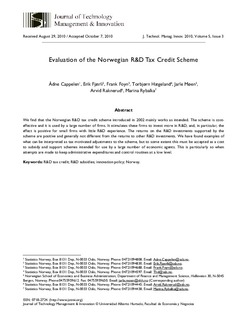| dc.contributor.author | Møen, Jarle | |
| dc.contributor.author | Cappelen, Ådne | |
| dc.contributor.author | Fjærli, Erik | |
| dc.contributor.author | Foyn, Frank | |
| dc.contributor.author | Hægeland, Torbjørn | |
| dc.contributor.author | Raknerud, Arvid | |
| dc.contributor.author | Rybalka, Marina | |
| dc.date.accessioned | 2012-12-04T11:36:41Z | |
| dc.date.available | 2012-12-04T11:36:41Z | |
| dc.date.issued | 2010 | |
| dc.identifier.issn | 0718-2724 | |
| dc.identifier.uri | http://hdl.handle.net/11250/163552 | |
| dc.description.abstract | We find that the Norwegian R&D tax credit scheme introduced in 2002 mainly works as intended. The scheme is costeffective
and it is used by a large number of firms. It stimulates these firms to invest more in R&D, and, in particular, the
effect is positive for small firms with little R&D experience. The returns on the R&D investments supported by the
scheme are positive and generally not different from the returns to other R&D investments. We have found examples of
what can be interpreted as tax motivated adjustments to the scheme, but to some extent this must be accepted as a cost
to subsidy and support schemes intended for use by a large number of economic agents. This is particularly so when
attempts are made to keep administrative expenditures and control routines at a low level. | no_NO |
| dc.language.iso | eng | no_NO |
| dc.publisher | Universidad Alberto Hurtado | no_NO |
| dc.subject | R&D tax credit | no_NO |
| dc.subject | R&D subsidies | no_NO |
| dc.subject | innovation policy | no_NO |
| dc.subject | Norway | no_NO |
| dc.title | Evaluation of the Norwegian R&D tax credit scheme | no_NO |
| dc.type | Journal article | no_NO |
| dc.type | Peer reviewed | no_NO |
| dc.subject.nsi | VDP::Social science: 200::Economics: 210::Economics: 212 | no_NO |
| dc.source.volume | 5 | no_NO |
| dc.source.journal | Journal of Technology Management & Innovation | no_NO |
| dc.source.issue | 3 | no_NO |
